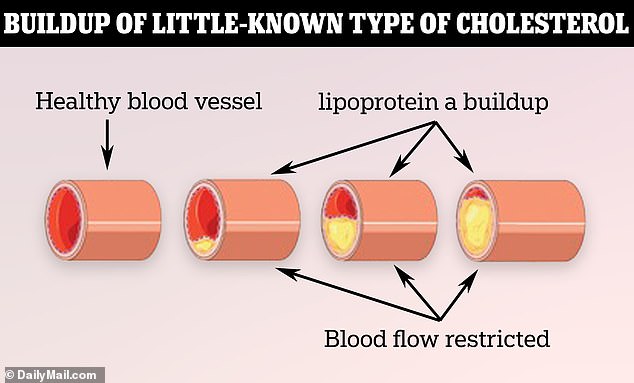Experts have warned that up to 65 million Americans could be at risk of a fatal stroke or heart attack in middle age due to a little-known, “silent killer” cholesterol disease.
It is well known that fatty deposits called high cholesterol, specifically a type called LDL, are a major risk factor for heart disease and stroke because they damage blood vessels, increasing the risk of life-threatening blood clots.
However, doctors now warn about the harm of a specific type of this substance called lipoprotein a.
It is known to be more harmful than other types of LDL, as it is made from “sticky” proteins that allow it to quickly form clumps, interfering with healthy blood flow.
Also known as Lp(a), levels of this type of cholesterol are determined almost entirely by genetics and there are currently no approved treatments to reduce them.
Lipoprotein (a) has specific properties that make it particularly “sticky.” Once in the blood vessel, the particles accumulate and stick to arterial walls, restricting crucial blood flow.
Studies show that people living with high levels of lipoprotein a have a risk two or three times higher of suffering a heart attack and risk almost twice as high of stroke compared to those with normal levels.
People with high levels often suffer heart attacks or strokes at a relatively young age, such as between 40 and 50 years old.
Even if a person’s LDL cholesterol level is low, their Lp(a) could be high, meaning that regular testing for high cholesterol will not detect it.
Now, a growing chorus of doctors is calling for more comprehensive cholesterol testing that can detect high levels of Lp(a) to help patients mitigate their risks for heart disease and stroke.
said Dr. Sahil Parikh, director of endovascular services at Columbia University Irving Medical Center in New York. NBC News: ‘The challenge has been: if you do a test to detect something and there is no treatment for it, are you doing the patient any favors?

Lori Welsh (left) said she felt empowered knowing that her Lp(a) levels are high, something that runs in her family. Her mother was able to extend her own life decades beyond that of her ancestors with that knowledge, using it to make better life decisions that kept her overall heart disease risk low.
‘I didn’t use to test for things I couldn’t treat. But now I know, because I know that on the horizon we will have good treatments. It gives hope to patients.”
An estimated 65 million Americans, nearly one in five, have elevated Lp(a) levels.
Because the amount in a person’s blood is determined almost exclusively by the lipoprotein(a) gene, many patients and providers feel helpless.
Tests are available at some specialized centers throughout the country, usually at a high cost.
But many doctors choose not to measure it. That means millions of Americans live their lives unaware that their life expectancy could be far below the national average of 77 years.
Dr. Enkhmaa Byambaa, a cardiovascular disease researcher at the University of California Davis, saying: ‘A patient’s Lp(a) levels are one of the strongest indicators of their genetic risk for cardiovascular disease.
«Despite the association between Lp(a) and cardiovascular diseases, it goes unnoticed. “It is not as well understood as other risk factors and current tests are not well standardized.”
There are no treatments on the market for elevated Lp(a), although several are in development.
However, doctors say it is still worth testing patients as there are steps they can take to reduce the risk of high LDL cholesterol, which often combines with high Lp(a) to produce the health problems. more serious.

Before 2020, death rates from heart disease had been declining, but rose again with the onset of the pandemic.
Lori Welsh, 51, a native of Dublin, Ohio, said discovering her family history of high Lp(a) has proven to be an immeasurable benefit to her and her mother’s health.
Welsh told NBC News: “If you go back five generations in my mother’s family, they all died of a heart attack or a stroke.” Nobody was over 54 years old.”
He was 47 years old when he suffered a heart attack. Doctors later told him that he had a 90 percent blockage in his anterior descending artery, which meant there was almost no blood getting to his heart.
His mother suffered the first of three heart attacks when she was around 40 years old. When doctors finally tested her Lp(a) levels, she was better able to control her other risk factors through a healthy diet and regular exercise.
He ultimately lived well into his 70s, decades older than his ancestors.
Mrs Welsh said: “The only difference between her and those five generations was the knowledge that she had lipoprotein (a). That made the difference.”
Dr. Gregory Katz, a cardiologist and professor at New York University Grossman School of Medicine, saying: ‘An argument I’ve made before is that empowering patients to understand risk is very important. But knowing Lp(a) doesn’t just empower the patient: it changes the way I treat someone, both in terms of diagnostic testing and treatment.
“If Lp(a) is high, I’m more aggressive about monitoring other risk factors; I’m more likely to recommend antihypertensives and lipid-lowering medications, and I’m definitely a little more aggressive about checking a score of calcium for personalized risk prediction. .’
Lp(a) is made up of particularly sticky combinations of protein and fat particles.
A person with elevated levels of Lp(a) particles in their blood is more likely to see an overall buildup of “bad” LDL cholesterol, which can build up in blood vessels over time.
It sticks to the walls of your arteries to form plaques, making them narrower and reducing blood flow.
Some of the plaques that build up in the arteries can rupture.
The body perceives plaque rupture as an injury and immediately goes into action to stop excessive bleeding by forming a clot.
It continually grows, blocking healthy blood flow and causing a potentially serious heart attack or stroke.
Currently, major pharmaceutical companies have several treatments for high Lp(a) in development.
Eli Lilly’s lepodisiran candidate was shown in one trial to reduce the Lp(a) protein level by more than 94 percent after a single treatment, and protein levels remained low for nearly a year.
Amgen is working on its own drug called olpasiran, which in a trial was shown to reduce Lp(a) levels in more than 95 percentwhile Novartis’ drug pelacarsen reduced Lp(a) in 72 to 80 percent depending on the dose.
Lori Welsh is currently enrolled in a pelacarsen trial at Ohio University Wexner Medical Center, although she does not know whether she is receiving the drug candidate or a placebo dose.
The goal of most cardiologists treating people with high Lp(a) levels is to keep them alive until one of several drug candidates comes to market.


